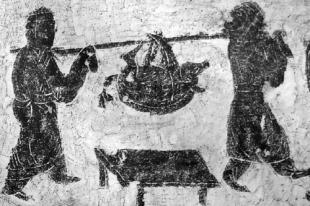5,000 years riding high on the hog


Two thousand years ago, privileged Chinese, such as aristocrats or superrich businesspeople, could expect a lot upon their deaths.
Their remains would most likely be encased in jade armor sewn with golden thread. Their heads would be set to rest on gilt bronze pillows inlaid with jade disks. The deceased, who were likely surrounded with luxury in life, would possess two objects-flat jade cicadas in their mouths and columnar jade pigs near their hands.
"The cicadas and the pigs were de rigueur for a man honored with a proper burial, since they represented the two crucial elements anyone would have wished for," says Liu Yunhua, a researcher with the Hebei Provincial Museum in Shijiazhuang.
Items unearthed from the burial ground of a vassal king in Mancheng county in Hebei province today constitute one of the country's best-known archeological discoveries from the Han Dynasty (206 BC-AD 220).
"Cicadas, which ancient Chinese believed fed on unspoiled dewdrops, symbolized virtue, while pigs represented wealth," Liu says.
"This funerary tradition started to form at the beginning of the Han Dynasty and had a firm hold on people's imaginations for more than three centuries. It only began to wane at the end of the Han era, when China was torn by war."
In recent decades, archeological excavations have turned up enough jade pigs-also known as zhu wo, which translates as "pig handles"-from Han tombs that almost every Chinese museum with a serious ancient jade collection displays at least one.
But the styles differ over time, says Ding Zhe, an antique-jade connoisseur.
"In the first half of the Han, the jade pigs were rendered more cursively. The entire animal was tubular, with a curled tail, pricked ears and a wrinkled snout indicated by only a few deep marks made by a hand-operated jade-grinding wheel. Today, the style is called han ba diao, or the "eight scratches of the Han knife".
"Eight" in this case refers to the artful precision with which a jade carver from the time handled the precious material."
But the style became more realistic over the next 200 years, as the jade pigs' identity as a status symbol matured.
It wasn't uncommon for aristocratic families to own pig farms, according to historical records. The life of a person whose wealth afforded ease without court politics' entanglements would have included more than a few pigs.
By that time, the pig had lost its supernatural connotations and was viewed as property.
"Long before that, pigs and their ancestors, wild boars, were given a more elevated status," Ding says.





































